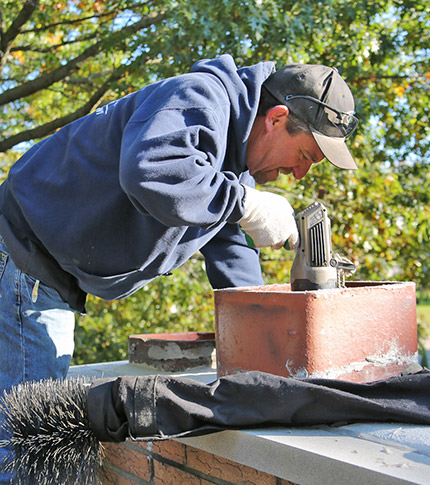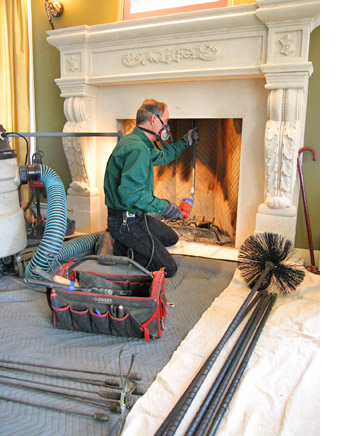Secure: Chimney Clean San Jose Professionals at Your Service
Wiki Article
Smokeshaft Cleaning: A Step-by-Step Overview to Preserving a Healthy Fireplace
Regular smokeshaft cleansing is a vital component of this maintenance routine. By complying with these standards, you will discover how to gather the essential tools, execute an aesthetic examination, clear debris and accumulation, move the chimney, and finish the final actions for continuous maintenance.Collecting the Necessary Tools
To begin the process of smokeshaft cleaning, the first step is to gather all the essential tools. Having the right devices available makes sure a secure and efficient cleansing process. The important tools for smokeshaft cleaning consist of a chimney brush, a ladder, drop towels or plastic sheets, a flashlight, handwear covers, and a dust mask.The chimney brush is the primary tool used to eliminate residue and creosote build-up from the flue - Chimney Clean San Jose. It is vital to pick a brush that matches the dimension and shape of your chimney.
Ground cloth or plastic sheets are critical for safeguarding the bordering area from dirt and debris. They assist make and contain the mess cleaning simpler. A flashlight is essential for checking the smokeshaft's interior for any type of indicators of damage or obstructions. Gloves are needed to safeguard your hands from soot and various other damaging substances, while a dust mask helps protect against the inhalation of debris.
Executing a Visual Assessment

Making use of a flashlight, thoroughly take a look at the indoor walls of the smokeshaft for any type of indications of damage, such as splits, loose bricks, or mortar degeneration. These issues can compromise the chimney's structural stability and present a major security danger. Additionally, check for any kind of signs of water damage, such as discoloration or efflorescence, as this can indicate a dripping smokeshaft cap or flashing.
Next, inspect the chimney flue for any type of blockages. Seek the visibility of nesting products, leaves, or particles that may have gathered with time (Chimney Clean San Jose). These blockages can restrict air flow, boost the danger of carbon monoxide buildup, and prevent the smokeshaft's capacity to properly vent smoke
Throughout the aesthetic evaluation, pay very close attention to the smokeshaft crown, which is the top surface area that protects the chimney from moisture. Search for splits or missing items in the crown, as these can allow water to enter the smokeshaft and trigger considerable damages.
Cleaning Particles and Accumulation
After finishing the visual assessment, the next action in chimney cleaning involves cleaning debris and build-up to guarantee the correct performance of the fire place. Over time, debris such as fallen leaves, twigs, and animal nests can accumulate in the chimney, obstructing the flow of air and triggering prospective fire hazards.To clear particles and build-up, it is essential to utilize the right devices and methods. A chimney brush, especially designed for this purpose, is utilized to remove loosened debris and creosote from the smokeshaft walls. It is crucial to pick a brush that matches the size of your smokeshaft to guarantee effective cleansing. Before beginning the cleaning procedure, see to it to cover the fire place open up to avoid particles from coming under the area.
To begin, put the brush right into the smokeshaft and relocate up and down, scrubbing the wall surfaces to dislodge any debris or creosote. Use a sweeping movement to make sure detailed cleaning. It is suggested to begin with the base and work your method up. When the cleaning is full, utilize a hoover or a smokeshaft brush expansion to get rid of the dislodged debris from the fireplace.

Brushing Up the Smokeshaft
The sweeping of the chimney is a vital action in keeping a healthy and balanced fire place. Over time, soot, creosote, and other debris can collect in the smokeshaft, blocking the circulation of air and possibly triggering a harmful accumulation of flammable materials. Normal smokeshaft sweeping not just ensures appropriate ventilation but likewise stops the risk of smokeshaft fires.When it comes to smokeshaft sweeping, it is highly recommended to hire a specialist smokeshaft sweep. These specialists have the understanding and tools needed to securely and successfully eliminate the accumulated particles from your smokeshaft.
It is important to note that the regularity of chimney sweeping relies on numerous variables, such as the kind of fuel made use of, the amount of use, and the kind of chimney. As a basic general rule, it is recommended to have your chimney brushed up and inspected at the very least as soon as a year.
Last Steps and Upkeep
To guarantee recurring maintenance and optimal performance, it is important to implement routine upkeep methods and adhere to a detailed set of last actions for your fireplace. After finishing the smokeshaft sweeping procedure, the primary step in the last maintenance is to inspect the view website smokeshaft cap and stimulate arrestor. These parts avoid particles, animals, and rainwater from going into the chimney. Inspect for any signs of damages or obstruction, and clean or fix them if needed.
Examine the within of the fire place for any type of signs of wear and tear, such as fractures, loose bricks, or harmed mortar. These concerns can impact the architectural integrity and safety of the fireplace. Speak with a professional chimney sweep or mason to resolve them promptly. if any problems are identified.
Ultimately, think about installing carbon monoxide detectors near the fireplace and throughout your home. These gadgets can find the visibility of this unsafe gas, supplying a very early caution system in case of a smokeshaft malfunction. Regularly check and change the batteries in these detectors to ensure their performance.
Final Thought
look at here nowTo conclude, following a step-by-step guide for smokeshaft cleansing is vital in preserving a healthy fireplace. By gathering the needed tools, performing a visual evaluation, removing particles and accumulation, and sweeping the smokeshaft, house owners can make certain the safety and security and effectiveness of their fire place. Normal maintenance and cleaning will help prevent smokeshaft fires and boost air quality in the home. It is vital to focus on smokeshaft cleansing as a part of total home upkeep.
The essential devices for smokeshaft cleansing include a chimney brush, a ladder, drop cloths or plastic sheets, a flashlight, gloves, and a dirt mask.
A chimney brush, especially created for this purpose, is made use of to get rid of loose debris and creosote from the smokeshaft wall surfaces. Regular chimney brushing up not just ensures correct ventilation yet also protects against the risk of chimney fires.
When it comes to smokeshaft sweeping, it is extremely advised to employ a professional chimney sweep. After completing the chimney sweeping process, the very first step in the last upkeep is to examine the smokeshaft cap and trigger arrestor.
Report this wiki page